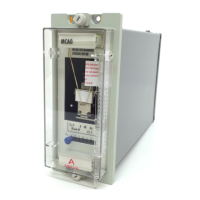2
The Application of
High Impedance Relays
Figure 1:
Principle of high impedance
protection
Introduction
The application of the MCAG14/
34, MFAC14/34 and MCTI14/34
relays to the protection of machines,
power transformers and busbar
installations is based on the high
impedance differential principle,
offering stabiliy for any type of fault
occurring outside the protected zone
and satisfactory operation for faults
within the zone
A high impedance relay is defined
as a relay or relay circuit whose
voltage setting is not less than the
calculated maximum voltage which
can appear across its terminals
under the assigned maximum
through fault current condition.
It can be seen from Figure 1, that
during an external fault the through
fault current should circulate
between the current transformer
secondaries. The only current that
can flow through the relay circuit is
that due to any difference in the
current transfomer outputs for the
same primary current. Magnetic
saturation will reduce the output of
a current transformer and the most
extreme case for stability will be if
one current transformer is
completely saturated and the other
unaffected. This condition can be
approached in busbar installations
due to the multiplicity of infeeds and
extremely high fault level. It is less
likely with machines or power
transformers due to the limitation of
through fault level by the protected
unit’s impedance, and the fact that
the comparison is made between a
limited number of current
transformers. Differences in current
transformer remanent flux can,
however, result in asymmetric
current transformer saturation with
all applications.
Calculations based on the above
extreme case for stability have
become accepted in lieu of
conjunctive scheme testing as being
a satisfactory basis for application.
At one end the current transformer
can be considered fully saturated
with its magnetising impedance
ZMB short circuited while the current
transformer at the other end, being
unaffected, delivers its full current
output which will then divide
between the relay and the saturated
current transformer. This division will
be in the inverse ratio of R
RELAY CIRCUIT
and R
CTB
+2R
L
and obviously, if
R
RELAY CIRCUIT
is high compared with
R
CTB
+ 2R
L
, the relay will be
prevented from undesirable
operation, as most of the current will
pass through the saturated current
transformer.
To achieve stability for external
faults, the stability voltage for the
protection (V
S
) must be determined
in accordance with formula 1 and
formula 2 for the MCAG/MFAC
and MCTI respectively. The setting
will be dependent upon the
maximum current transformer
secondary current for an external
fault (I
f
) and also on the highest loop
resistance value between the current
transformer common point and any
of the current transformers
(R
CT
+ 2R
L
).

